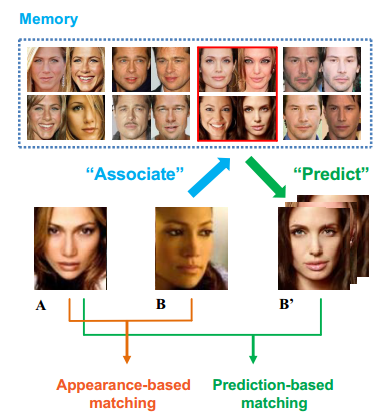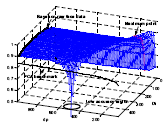Human perception demonstrates strong ability to understand and interpret human face, such as the recognition of human identities and facial expressions. This project aims at designing face recognition algorithms and systems to bridge the gap between computer vision and human vision. We are working on various topics, including face sketch synthesis and recognition, face recognition based on subspace learning, graph-based face recognition, and face recognition using deep learning.
* PCA, LDA, and Bayesian analysis are the three most representative subspace face recognition approaches. In the topic of face recognition using subspace learning, we show that they can be unified under the same framework. We model face difference with three components: intrinsic difference, transformation difference, and noise. The framework is constructed by using this face difference model and a detailed subspace analysis on the three components. Based on the framework, a unified subspace analysis method is developed using PCA, Bayes, and LDA as three steps. A 3D parameter space is constructed using the three subspace dimensions as axes. Searching through this parameter space, we achieve better recognition performance than standard subspace methods.
Highlights

An associate-predict model for face recognition
Q. Yin, X. Tang, J. Sun, IEEE Conference on Computer Vision and Pattern Recognition (CVPR), 2011.
Handling intra-personal variation is a major challenge
in face recognition. It is difficult how to appropriately
measure the similarity between human faces under significantly different settings (e.g., pose, illumination, and expression). In this paper, we propose a new model, called
“Associate-Predict” (AP) model, to address this issue. The
associate-predict model is built on an extra generic identity
data set, in which each identity contains multiple images
with large intra-personal variation.
PDF

Face recognition with learning-based descriptor
Z. Cao, Q. Yin, X. Tang, J. Sun, in Proceedings of IEEE Computer Society Conference on Computer Vision and Patter Recognition (CVPR) 2010
We present a novel approach to address the representation issue and the matching issue in face recognition (verifi-
cation). Firstly, our approach encodes the micro-structures
of the face by a new learning-based encoding method. Unlike many previous manually designed encoding methods
(e.g., LBP or SIFT), we use unsupervised learning techniques to learn an encoder from the training examples,
which can automatically achieve very good tradeoff between discriminative power and invariance. Then we apply PCA to get a compact face descriptor.
PDF

A Unified Framework for Subspace Face Recognition
X. Wang and X. Tang, IEEE Transactions on Pattern Analysis and Machine Intelligence (PAMI), Vol. 26, No.9, pp. 1222-1228, 2004.
PCA, LDA, and Bayesian analysis are the three most representative
subspace face recognition approaches. In this paper, we show that they can be
unified under the same framework. We first model face difference with three
components: intrinsic difference, transformation difference, and noise. A unified
framework is then constructed by using this face difference model and a detailed
subspace analysis on the three components.
PDF

Random Sampling for Subspace Face Recognition
X. Wang and X. Tang, International Journal of Computer Vision (IJCV), Vol. 70, No. 1, pp 91-104, 2006.
Subspace face recognition often suffers from two problems: (1) the training sample set is small compared
with the high dimensional feature vector; (2) the performance is sensitive to the subspace dimension. Instead of
pursuing a single optimal subspace, we develop an ensemble learning framework based on random sampling on
all three key components of a classification system: the feature space, training samples, and subspace parameters.
Fisherface and Null Space LDA (N-LDA) are two conventional approaches to address the small sample size problem.
PDF